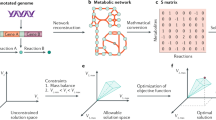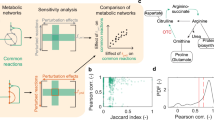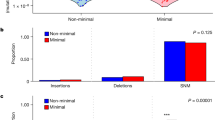Abstract
It is possible to infer aspects of an organism's lifestyle from its gene content1. Can the reverse also be done? Here we consider this issue by modelling evolution of the reduced genomes of endosymbiotic bacteria. The diversity of gene content in these bacteria may reflect both variation in selective forces and contingency-dependent loss of alternative pathways. Using an in silico representation of the metabolic network of Escherichia coli, we examine the role of contingency by repeatedly simulating the successive loss of genes while controlling for the environment. The minimal networks that result are variable in both gene content and number. Partially different metabolisms can thus evolve owing to contingency alone. The simulation outcomes do preserve a core metabolism, however, which is over-represented in strict intracellular bacteria. Moreover, differences between minimal networks based on lifestyle are predictable: by simulating their respective environmental conditions, we can model evolution of the gene content in Buchnera aphidicola and Wigglesworthia glossinidia with over 80% accuracy. We conclude that, at least for the particular cases considered here, gene content of an organism can be predicted with knowledge of its distant ancestors and its current lifestyle.
This is a preview of subscription content, access via your institution
Access options
Subscribe to this journal
Receive 51 print issues and online access
$199.00 per year
only $3.90 per issue
Buy this article
- Purchase on Springer Link
- Instant access to full article PDF
Prices may be subject to local taxes which are calculated during checkout


Similar content being viewed by others
References
Tyson, G. W. et al. Community structure and metabolism through reconstruction of microbial genomes from the environment. Nature 428, 37–43 (2004)
Koonin, E. V. Comparative genomics, minimal gene-sets and the last universal common ancestor. Nature Rev. Microbiol. 1, 127–136 (2003)
Reed, J. L., Vo, T. D., Schilling, C. H. & Palsson, B. O. An expanded genome-scale model of Escherichia coli K-12 (iJR904 GSM/GPR). Genome Biol. 4, R54 (2003)
Price, N. D., Reed, J. L. & Palsson, B. O. Genome-scale models of microbial cells: evaluating the consequences of constraints. Nature Rev. Microbiol. 2, 886–897 (2004)
Edwards, J. S. & Palsson, B. O. The Escherichia coli MG1655 in silico metabolic genotype: its definition, characteristics, and capabilities. Proc. Natl Acad. Sci. USA 97, 5528–5533 (2000)
Gil, R., Latorre, A. & Moya, A. Bacterial endosymbionts of insects: insights from comparative genomics. Environ. Microbiol. 6, 1109–1122 (2004)
Klasson, L. & Andersson, S. G. Evolution of minimal-gene-sets in host-dependent bacteria. Trends Microbiol. 12, 37–43 (2004)
Burgard, A. P., Vaidyaraman, S. & Maranas, C. D. Minimal reaction sets for Escherichia coli metabolism under different growth requirements and uptake environments. Biotechnol. Prog. 17, 791–797 (2001)
Moran, N. A. & Mira, A. The process of genome shrinkage in the obligate symbiont Buchnera aphidicola. Genome Biol. 2, research0054 (2001)
Shigenobu, S., Watanabe, H., Hattori, M., Sakaki, Y. & Ishikawa, H. Genome sequence of the endocellular bacterial symbiont of aphids Buchnera sp. APS. Nature 407, 81–86 (2000)
van Ham, R. C. et al. Reductive genome evolution in Buchnera aphidicola. Proc. Natl Acad. Sci. USA 100, 581–586 (2003)
Tamas, I. et al. 50 million years of genomic stasis in endosymbiotic bacteria. Science 296, 2376–2379 (2002)
Akman, L. et al. Genome sequence of the endocellular obligate symbiont of tsetse flies, Wigglesworthia glossinidia. Nature Genet. 32, 402–407 (2002)
Nakabachi, A. & Ishikawa, H. Provision of riboflavin to the host aphid, Acyrthosiphon pisum, by endosymbiotic bacteria, Buchnera. J. Insect Physiol. 45, 1–6 (1999)
Baumann, P. et al. Genetics, physiology, and evolutionary relationships of the genus Buchnera—intracellular symbionts of aphids. Ann. Rev. Microbiol. 49, 55–94 (1995)
Hanley, J. A. & McNeil, B. J. The meaning and use of the area under a receiver operating characteristic (ROC) curve. Radiology 143, 29–36 (1982)
Kumari, S., Tishel, R., Eisenbach, M. & Wolfe, A. J. Cloning, characterization, and functional expression of acs, the gene which encodes acetyl coenzyme A synthetase in Escherichia coli. J. Bacteriol. 177, 2878–2886 (1995)
Zientz, E., Dandekar, T. & Gross, R. Metabolic interdependence of obligate intracellular bacteria and their insect hosts. Microbiol. Mol. Biol. Rev. 68, 745–770 (2004)
Nogge, G. Significance of symbionts for the maintenance of an optimal nutritional state for successful reproduction in haematophagous arthropods. Parasitology 82, 101–104 (1981)
Cormen, T. H., Leiserson, C. E., Rivest, R. L. & Stein, C. Introduction to Algorithms (MIT Press, Cambridge, MA, 2001)
Burgard, A. P., Nikolaev, E. V., Schilling, C. H. & Maranas, C. D. Flux coupling analysis of genome-scale metabolic network reconstructions. Genome Res. 14, 301–312 (2004)
Travisano, M., Mongold, J. A., Bennett, A. F. & Lenski, R. E. Experimental tests of the roles of adaptation, chance, and history in evolution. Science 267, 87–90 (1995)
Mushegian, A. R. & Koonin, E. V. A minimal gene set for cellular life derived by comparison of complete bacterial genomes. Proc. Natl Acad. Sci. USA 93, 10268–10273 (1996)
Gil, R., Silva, F. J., Pereto, J. & Moya, A. Determination of the core of a minimal bacterial gene set. Microbiol. Mol. Biol. Rev. 68, 518–537 (2004)
Westers, H. et al. Genome engineering reveals large dispensable regions in Bacillus subtilis. Mol. Biol. Evol. 20, 2076–2090 (2003)
Kolisnychenko, V. et al. Engineering a reduced Escherichia coli genome. Genome Res. 12, 640–647 (2002)
Hutchison, C. A. et al. Global transposon mutagenesis and a minimal Mycoplasma genome. Science 286, 2165–2169 (1999)
Nilsson, A. I. et al. Bacterial genome size reduction by experimental evolution. Proc. Natl Acad. Sci. USA 102, 12112–12116 (2005)
Oliver, S. G. From DNA sequence to biological function. Nature 379, 597–600 (1996)
Mira, A. & Moran, N. A. Estimating population size and transmission bottlenecks in maternally transmitted endosymbiotic bacteria. Microb. Ecol. 44, 137–143 (2002)
Acknowledgements
We thank C. von Mering for providing early access to the updated STRING database. C.P., B.P. and P.C. are supported by the Hungarian Scientific Research Fund (OTKA). C.P. is also supported by an EMBO Long-term Fellowship. B.P. is a Fellow of the Human Frontier Science Program. M.J.L. acknowledges financial support by the Deutsche Forschungsgemeinschaft. Work on systems biology in S.G.O.'s laboratory is supported by the Biotechnology and Biological Sciences Research Council.
Author information
Authors and Affiliations
Corresponding author
Ethics declarations
Competing interests
Reprints and permissions information is available at npg.nature.com/reprintsandpermissions. The authors declare no competing financial interests.
Supplementary information
Supplementary Notes
This file contains the Supplementary Methods and Supplementary Tables 1–12. (DOC 760 kb)
Supplementary Table 13
Metabolic gene content of endosymbionts and simulated minimal genomes. (PDF 129 kb)
Rights and permissions
About this article
Cite this article
Pál, C., Papp, B., Lercher, M. et al. Chance and necessity in the evolution of minimal metabolic networks. Nature 440, 667–670 (2006). https://doi.org/10.1038/nature04568
Received:
Accepted:
Issue Date:
DOI: https://doi.org/10.1038/nature04568
This article is cited by
-
Nutrition or nature: using elementary flux modes to disentangle the complex forces shaping prokaryote pan-genomes
BMC Ecology and Evolution (2022)
-
Basics on network theory to analyze biological systems: a hands-on outlook
Functional & Integrative Genomics (2022)
-
Stoichiometric Modeling of Artificial String Chemistries Reveals Constraints on Metabolic Network Structure
Journal of Molecular Evolution (2021)
-
Intraspecific variation in traits and tree growth along an elevational gradient in a subtropical forest
Oecologia (2019)
-
Metabolic model-based analysis of the emergence of bacterial cross-feeding via extensive gene loss
BMC Systems Biology (2018)
Comments
By submitting a comment you agree to abide by our Terms and Community Guidelines. If you find something abusive or that does not comply with our terms or guidelines please flag it as inappropriate.



